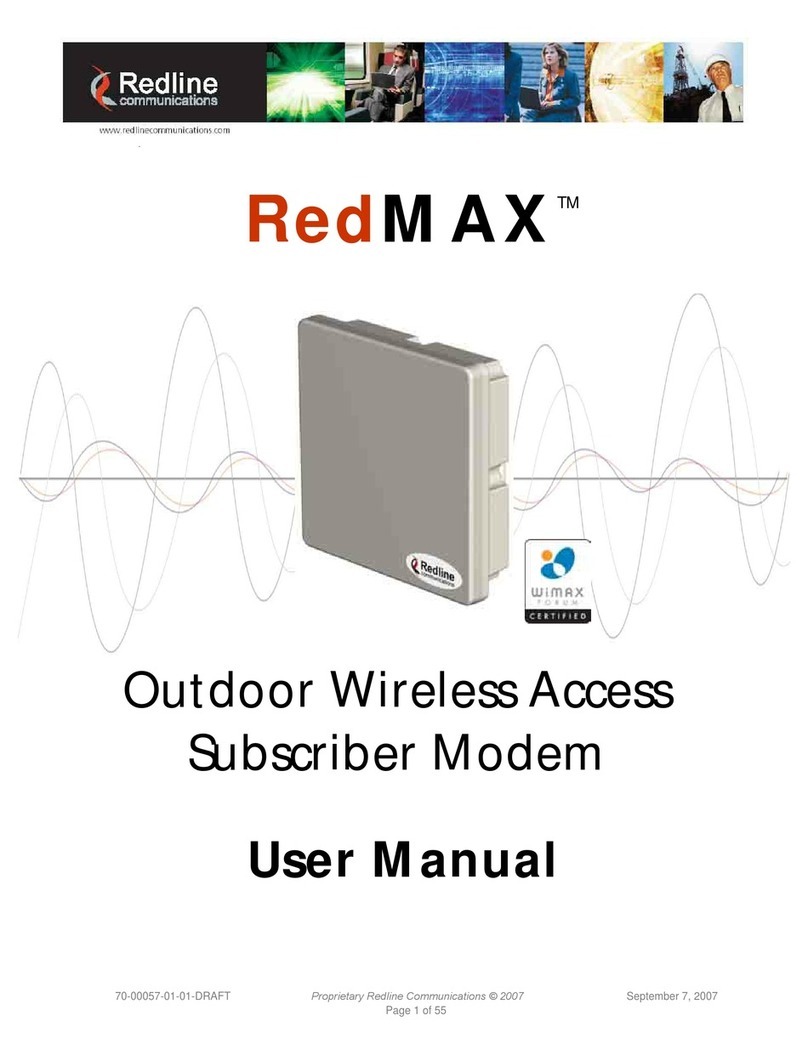
AN-30e
user manual
70-00035-01 Proprietary Redline Communications © 2004 November 16, 2004
Page 4 of 103
5.4 System Logs............................................................................................ 37
5.5 Configure System .................................................................................... 38
5.5.1 Ethernet Configuration:........................................................................ 38
5.5.2 Wireless Configuration: ....................................................................... 41
5.5.3 System Configuration Buttons ............................................................. 46
5.6 Upload Software ...................................................................................... 47
5.7 Product Options....................................................................................... 48
5.7.1 Entering Option Keys........................................................................... 48
5.7.2 TDM Options ....................................................................................... 48
5.7.3 Ethernet Options.................................................................................. 48
5.8 System Password Screen ....................................................................... 49
5.9 TDM Configuration Settings .................................................................... 50
5.9.1 How to Use Apply and Save................................................................ 51
5.9.2 TDM Config - General Settings............................................................ 52
5.9.3 TDM Config - Port Settings.................................................................. 54
5.9.4 TDM Config - Bundle Selection ........................................................... 56
5.9.5 TDM System Configuration Control Buttons........................................ 59
5.10 TDM Statistics ......................................................................................... 60
5.10.1 TDM Statistics - Port Selection............................................................ 60
5.10.2 TDM Statistics - Statistics Screen........................................................ 61
6TDM Over Wireless................................................................................ 63
6.1 Bandwidth Requirements ........................................................................ 63
6.1.1 Maximum Uncoded Burst Rates .......................................................... 63
6.1.2 Evaluating TDM Throughput Requirements ........................................ 64
6.1.3 Mobility Networks ................................................................................ 64
6.1.4 Enterprise Networks ............................................................................ 65
6.1.5 Evaluating Ethernet Throughput.......................................................... 67
6.1.6 Clock Synchronization ......................................................................... 68
7Diagnostics and Troubleshooting ....................................................... 69
7.1 Factory Default Settings .......................................................................... 69
7.2 Troubleshooting the Web Interface ......................................................... 70
7.3 Troubleshooting The RF.......................................................................... 71
7.4 System Error Log Messages ................................................................... 73
7.5 Replacing System Fuse........................................................................... 75
8Appendix ................................................................................................ 77
8.1 System Specifications ............................................................................. 77
8.2 DC Power Supply Cable Connections..................................................... 80
8.3 Antenna and Power Specifications.......................................................... 81
8.3.1 T-58 Radio: Antenna Power Specifications ......................................... 81
8.3.2 T-54 Radio: Maximum RF Power vs. Antenna Gain............................ 82
8.3.3 T-54 Radio: Operational Power (FCC) ................................................ 83
8.4 CLI Interface ............................................................................................ 84
8.4.1 Console (RS-232) Port ........................................................................ 84
8.4.2 Connecting via Telnet .......................................................................... 85
8.4.3 CLI Commands.................................................................................... 85




























